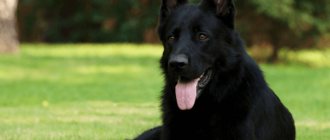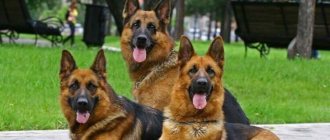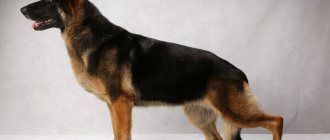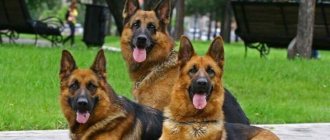A puppy's small age does not mean that he needs less attention and training.
Especially when it comes to German Shepherds.
This breed can become a true friend and protector.
But only if you start caring for and training him from a young age.
But this also has its own characteristics.
Let's find out about everything in detail.
Further in the article, detailed information on the care and education of a puppy will be provided.
What does a German Shepherd puppy look like at 3 months old?
At three months of age, a German Shepherd puppy begins to look more and more like an adult dog. His ears begin to stand up, his color gradually changes, his limbs begin to stretch out - his hind legs and large joints on his front legs grow.
The dog's tail also becomes more visible. The ears may still fall funny to the side, but most of the time they are now in an upright position.
At the same age, the puppy begins to shed.
In appearance, the dog still seems clumsy, parts of the body are disproportionate . This is due to the fact that the dog is entering adolescence and his body is just beginning to form.
This type of puppy indicates that maturation is in full swing. Over time, the awkwardness of his features will smooth out and cease to be so noticeable.
Once again about documents
The purity of any breed is recorded, first of all, in the documents for the dog!
The presence of documents confirms that only dogs of excellent quality are involved in breeding:
- correct exterior;
- excellent working qualities;
- excellent health.
The totality of this data determines the breeding value of the animal as a representative of the breed without breed defects.
Why is it important?
Breeders have long noticed the fact that exterior defects correspond to an unfavorable genotype. Thus, weakening of pigmentation (light eyes and nose) is often accompanied by cryptorchidism and disorders of the genitourinary system, instability in the development of the central nervous system.
Protruding eyes and flabby ears help to recognize metabolic imbalances and a predisposition to dysplasia.
This may not be observed in a given individual, but it will certainly “come out” in subsequent generations.
But the famous “pedigreed” mole on a German Shepherd has nothing to do with the high-breeding of the dog! It occurs as often in dogs of other breeds as in ordinary mongrels.
Puppy metric
Together with the puppy, you must receive a certificate (card) of the origin of your baby, which will indicate his date of birth, color, nicknames of himself and his parents, up to his great-grandfathers, with mandatory evaluations of rings and tests. Later you will exchange the certificate for a real pedigree.
Sample certificate (without stamps is not valid!)
If you have such a “puppy” card, the question is: “How to distinguish a German shepherd from a crossbreed or low-breed “shepheroid”?” - will disappear by itself.
Dog character
Despite the beginning of maturation, the puppy still remains a mischievous child by nature.
He plays pranks with pleasure and prefers to play rather than listen to his owner and be trained . This is the time when you need to be persistent and show the puppy that he must obey his owner.
Things in the apartment - furniture or shoes - can suffer from the dog's behavior. Therefore, it is important to walk the dog as much as possible in special areas where the puppy can throw out all the hyperactivity.
This behavior is explained by post-vaccination quarantine . Once it comes to an end, it will be easier to deal with the dog.
Three months is the right time to teach your dog to react to passers-by, guests and other dogs. This will help build the dog's balance.
But you shouldn’t take her to places where there are a lot of loud and frightening sounds - the puppy’s psyche has not yet fully formed, such an environment can contribute to the dog becoming nervous and fearful.
Pet's height and weight
Even at such a young age, the first developments between boys and girls of the German Shepherd begin to take shape..
The height of a male at 3 months is 42-48 cm, and his weight is 14-14.2 kg. For a female, these indicators are as follows: height – 40-46 cm, weight – 12-12.3 kg.
Read more information about the height and weight of the German Shepherd here.
Although there is no noticeable difference in height, as can be seen from the parameters, the weight of puppies of different sexes differs significantly from each other.
CAREFULLY!
Deviation from standard indicators may be the beginning of any diseases or deviations in the puppy’s health.
If you notice a lack of weight or height, it is better to contact your veterinarian.
How much does a dog cost?
The cost of a puppy is influenced by several factors: the presence of a pedigree and veterinary passports; the higher the titles of the parents, the more expensive the animal will be.
The region where the animal is purchased is important (in the capital, dogs cost more than in the provinces). The price is affected by color and age.
The most expensive are white dogs; this is an extremely rare color; for a black dog you will have to pay much less. And the older the cub, the cheaper it will cost.
The cost of a German Shepherd is significantly influenced by the class of the animal. If they are purchased for breeding, then the new owner is given a veterinary passport and card. The price of breeding class puppies ranges from 25,000 to 65,000 rubles.
Show class pets are bought for participation in exhibitions; they are the most expensive (from 1000 to 10000 dollars). The winners of junior shows are sold at six months of age, when external characteristics are already expressed. They are the most valuable.
The pet class includes dogs that are purchased to guard the home or as a family friend. Such individuals may not have documents or titled parents; their cost is 3000-5000 rubles.
What is better – natural or dry food?
Every owner thinks about which food is best for a pet. The debate over natural food and dry food never subsides.
Each of these foods can meet the needs of the puppy, the main thing is to follow the most important instructions in feeding the dog:
- When choosing dry food, opt for premium or super-premium class;
- Try to choose food for your breed;
- The food must be suitable for the dog’s age;
- If you choose natural food, the dog’s diet should be balanced;
- Natural food will require special vitamins;
- You must approach the choice of products responsibly: buy only fresh ones, exclude those that will harm the dog.
Expert opinion
Kozhevin Semyon Kirillovich
Expert dog handler.
“Food for a puppy of this breed is a very important matter. I know that many owners who are professional breeders choose natural food, believing that it is healthier for the dog. But they have enough time to cook and buy all the necessary products. People who get a German Shepherd “for the soul, and not “for business”, prefer dry food. If the dog's nutrition is correct, then no matter what type of food you choose, the dog will be happy."
Daily norm
The daily amount of dry food is indicated on the packaging. If the dog eats natural food, then the daily norm is calculated as a percentage of its weight:
- 6-7% under 6 months of age;
- 3-4% over 6 months of age.
Since among German shepherds there are both active representatives of the breed and couch bumpers, it is necessary to focus, first of all, on the appearance of the dog :
- if her ribs are sticking out, then you should increase the portion;
- If she quickly gains fat, it is recommended to give her less food.
Basic feeding rules
Rules to follow when feeding a German Shepherd:
- To keep your puppy healthy, it is important to follow certain rules when feeding it;
- Food should be warm, not hot, and not from the refrigerator;
- There should be no large pieces in the bowl so that the puppy does not choke - German shepherds do not chew food, but swallow it immediately;
- You need to feed your dog at the same time, regularly;
- You cannot overfeed your dog. This can lead to dehydration and volvulus;
- The puppy should always have clean drinking water available.
What not to feed
Under no circumstances should you feed your dog the following foods:
- Pork meat,
- Any bones
- Pasta,
- Bakery,
- Oranges, tangerines and lemons,
- Sausages, bacon, sausages and small sausages,
- Candies and chocolate,
- Pickled vegetables,
- I eat with spices
- Highly salty and spicy foods
- Beans and peas.
Otherwise, this food can lead to serious consequences: diarrhea, vomiting, stomach pain and increased gas formation, dehydration.
Feeding with natural food
Your dog's menu should include a variety of grains, fruits, vegetables and meat.
Pork should not be given to your German Shepherd as it can lead to obesity..
At 3 months, the menu should contain as much meat as possible. Protein is the basis of growth for a growing organism. The menu should also include cereals and vegetables - carbohydrates and fiber.
The best choice of meat is lean beef - raw or boiled . The meat should be finely chopped; it is not recommended to give minced meat: it forms pieces and is not completely digested.
The puppy can also eat chicken, rabbit and turkey. It is better to give eggs with porridge and not very often.
The puppy will like meat broths . They can be added to cereals instead of milk.
You can give large beef bones that are difficult to chew. Chicken can damage the dog's oral mucosa.
Suitable cereals for a German Shepherd include buckwheat, rice, millet, rolled oats and semolina. It is better to give vegetables raw: this way they will not lose their vitamins.
But it can also be boiled as a filler for porridges. Suitable ones include beets, tomatoes, zucchini, cabbage, cucumbers and others. And the puppy will like berries and apples - they can be added to cottage cheese.
Fermented milk products on the shepherd's menu should include low-fat kefir, cottage cheese, curdled milk, yogurt, and fermented baked milk . It is better to avoid foods with high fat content.
How and how much to feed
Meals at the age of three months should be four times a day. The volume of food for each feeding should be 300-400 g.
The feeding process should not exceed fifteen minutes.
If there is food left in the bowl, reduce the portion. If, on the contrary, the dog licks it, this is a reason to think about increasing it. In any case, this must be agreed with your veterinarian.
Prohibited Products
Since dogs, and especially puppies, do not digest starch and lactose well, it is better not to give potatoes and milk at all. Like other dogs, German Shepherds cannot eat anything fried, smoked, pickled, sweet or floury.
Eliminate various sausages and poultry bones.
To avoid disturbing your dog's digestion, do not feed him food from the table..
Vitamin supplements
To prevent your puppy from developing vitamin deficiency, do not forget to give him fresh greens - parsley, green onions, lettuce, spinach, beet and carrot tops, scalded nettles.
For these purposes, both sprouted oats and sprouted millet are suitable in an amount of no more than one tablespoon per day.
Mineral supplements you can offer your puppy include meat and bone meal and crushed shells . For proper hair growth, pharmaceutical sulfur is given, and yeast is given for digestion and appetite.
You can give your pet special vitamins and granules, but before doing this you should consult a specialist.
General recommendations
Any dog is not only a predator, but also a scavenger . Puppies in nature gain independence by 4–5 months, receiving mostly leftovers after a successful pack hunt. And these are not fillet pieces, but cartilage/bones and connective tissue that help animals grow.
Domestic dogs are pampered with chicken breasts, fillets and tenderloins, which contain a lot of extra amino acids that are harmful to the dog’s body: they are poorly digested or stored as fat, and sometimes provoke allergies (protein poisoning). The tender pulp contains almost no building materials for the formation of bones, joints and ligaments, which is why first-class meat should be replaced by offal and trimmings with cartilage, veins and even skin particles.
Important! Don’t be afraid to feed your puppy raw meat because of the risk of infection with Giardia, Salmonella, viruses, roundworms, etc. A dog's stomach juice neutralizes not only pathogenic microflora, but also cadaveric poison. You should also not be afraid of antibiotics and hormones, which are occasionally found in meat: these are extremely unstable compounds that have time to decompose before it gets into the bowl.
In the wild, the puppies get their own food, and until they learn how to do this, they live from hand to mouth, content with what the adult tribesmen leave. If you're lucky, the puppy eats the carrion, as often happens in a wolf pack: the younger ones find what the older ones have hidden. Along with rotten game, growing dogs get rodents, lizards and insects (if they catch them), as well as berries, roots, carrion and manure.
Ready food or natural food
When thinking about what to feed your German Shepherd puppy, choose BARF, which normalizes the gastrointestinal microflora responsible for immunity. Dogs fed porridge with boiled chicken or fed industrial food have a noticeably weaker immune system. By the way, a menu where carbohydrates predominate not only changes metabolism, but also has a bad effect on the dog’s nervous system, increasing inhibition processes. It is not surprising that a puppy placed on BARF becomes more energetic and even aggressive.
This is typical for a growing organism receiving proper nutrition . You just need to increase the time for walking and playing. Puppies, as a rule, willingly eat raw foods, but sometimes become capricious, refusing unfamiliar ones. In this case, a new ingredient is mixed into the tested one or a slice is placed in the mouth and closed, waiting for the puppy to swallow.
This is interesting! A healthy puppy (due to rapid growth and an undeveloped satiety center) is always hungry, and refusal to eat signals illness or overfeeding. In the second case, he is separated from the bowl for a couple of feedings or the ration is reduced by 1.5–2 times.
A German Shepherd puppy with a natural diet receives all trace elements/vitamins from fresh chopped vegetables/fruits (plus berries/greens) and raw meat products. Industrial vitamins, especially water-soluble ones, are highly undesirable as they are easy to overdose on. If you consider it necessary to feed your puppy with them, give half the dose, adhering to the course interval.
Pedigree feed lines
Let’s assume that when answering the question of what to feed your German Shepherd puppy, you leaned toward ready-made factory food (due to your own laziness, being busy at work, or simple irresponsibility). You will have to choose a commercial diet with all seriousness, remembering that your puppy’s bone structure continues to form, which means that economy and premium food stuffed with grains is contraindicated for him.
Holistic products under the Acana and Orijen brands (with high nutritional value and good meat content) occupy the first positions in the domestic ranking of ready-made feeds.
The following foods are recommended for puppies:
- Acana Puppy Large breed;
- Innova Puppy Dry Puppy Food;
- Orijen Puppy Large;
- Acana Puppy Small Breed;
- Nutro Ultra Holistic Puppy;
- Chicken Soup For The Puppy Lover's Soul;
- Innova Large Breed Puppy Dry.
Important! If raw cartilage and bones are not on your pet's menu, you will need to supplement the diet with calcium supplements (preferably in the form of calcium chelate/citrate). Dog breeders appreciated Welpenkalk (Canina) and Irish Cal (Beaphar).
What not to feed German Shepherd puppies
The udder, lung, and especially beef liver, which often causes diarrhea, are prohibited.
The following are also recognized as dangerous and unnecessary products:
- bones after heat treatment and tubular;
- bread, pastry and sweets;
- fried foods;
- spices and herbs;
- legumes and cabbage;
- plum and grapes;
- ketchup and mayonnaise.
From 1 to 2 months, a German Shepherd puppy is fed 5-6 times a day every 3-4 hours (with a break for sleep), increasing portions as the pet grows . From 2 months they switch to 3-4 meals a day, from 3 months they feed three times a day. From six months onwards, the feeding regimen resembles that of an adult (twice a day), with the proportion of animal proteins reduced to 3–5% of the shepherd’s weight. Remember that overfeeding (overloading undeveloped ligaments/joints) is harmful for puppies, which causes dogs to become raw and loose.
Checking your puppy for allergies
A considerable part of breeders are convinced that German Shepherd puppies from 4 to 8 months should be fed extremely moderately, observing specific requirements for protein components.
Otherwise, the program designed by nature fails, and the owner raises a dog that is poorly adapted to life, with low immunity and susceptible to allergic reactions (including food ones). If your puppy’s diet is as varied as possible, that’s great, but the downside of a rich menu is intolerance to one of the ingredients.
Important! To understand what product the body rejects, you need to keep your shepherd dog on an elimination diet. At the same time, you will figure out whether the irritant is really in the food: perhaps the allergy is associated with other factors.
There are several types of such diets, designed both for puppies who are accustomed to dry food, and for their peers who specialize in a raw food diet. Adherents of natural feeding identify food irritants according to the following scheme:
- For a month, the puppy is given one unfamiliar type of meat (lamb, venison, fish, etc.), adding a single carbohydrate side dish (rice, potatoes, rolled oats).
- In case of a normal reaction, a new ingredient is introduced every 1–1.5 weeks; if an undesirable reaction occurs, the product is excluded, waiting for the symptoms to subside.
- So, step by step, month after month, they build up a dog diet that is guaranteed to protect the puppy from allergic manifestations.
Fans of dry industrial diets should follow a similar algorithm, only using food with hydrolyzate for their shepherd dogs, where the proteins are crushed and practically digested. Hydrolysis transforms protein components almost into a related organism: it ceases to identify them as foreign and does not give an allergic reaction.
Many companies produce products with hydrolyzate, so choosing a safe diet is not a problem. However, we must take into account that these foods contain not only protein components (soy, chicken), but also many additives. This is why food with hydrolyzate cannot be considered a panacea: they are also introduced into the diet gradually, observing how the pet reacts.
In addition, with any elimination diet it is prohibited:
- feed with treats during training;
- allow eating food found on the street (if the puppy does not understand, put a muzzle on him);
- arrange snacks and give supplements to the norm;
- treat with pieces from the master's table;
- change your dog's cosmetics.
Return to content
Feeding dry food
How to choose?
When choosing food, immediately exclude all cheap ones. They will not be able to provide the puppy with all the vitamins and nutrients necessary for growth and development. Very often, abuse of such feeds leads to diseases in animals. The kidneys, liver and stomach suffer.
IMPORTANT!
You need to buy premium or super-premium food. They are not cheap, but they will help save a lot of time and will not harm the dog’s health.
If there is a lack of calcium, the puppy's ears begin to fall off..
Popular manufacturers:
- Acana;
- GO Natural;
- Grandorf;
- Orijen;
- Dukes Farm;
- Bosh;
- Eukanuba;
- Arden Grange.
How often to feed
Feeding your dog, as with natural food, is 4 times a day..
It is advisable to do this after a walk. Then let the puppy rest for several hours so that the food is digested.
Do I need to get vaccinated at this age?
The only vaccination that should be done after three months is against rabies. All other vaccinations are distributed throughout the dog’s life so that nothing serious occurs at this age .
Vaccinations have either already been done or the deadline for them has not yet come.
But sometimes it happens that the puppy’s second vaccination falls at three months. It depends on the age at which the first one was performed.
How to distinguish a boy from a girl?
At birth, puppies already have distinctive sexual characteristics, but the difference between males and females becomes clearly visible closer to a month and an inexperienced owner may have difficulty determining the sex of the newborn.
If you need to find out the puppy’s gender as early as possible, you should carefully examine the underbelly. If only the nipples and navel are visible, this is a bitch, whose genital organ is not so pronounced and is located almost between the hind legs, and if the genital organ is located just below the navel, it is a male.
There are also indirect signs that allow you to determine the gender of the puppy. Thus, it is believed that males are larger and more active than females. However, here everything depends on the character and characteristics of a particular individual - it often happens that it is the girls who are highly active in the litter.
Girl:
Boy:
Caring for a three month old puppy
Three months is the age when walking the dog should be in full swing. The first walks should not exceed five minutes, then gradually increase to 30-40 minutes.
If at first you need to hold the puppy in your arms, then teach him to walk on his own, make sure that he does not pick up anything from the ground.
Train him to use a leash, because large dogs like the German Shepherd cannot be walked without a leash, no matter how well trained he is.
NOTE!
A full walk should consist of communication with peers, games and jogging.
At this time, the puppy should know some commands and get used to using the toilet outside.
Dog hygiene consists of brushing, which should occur 1-2 times a week, cleaning the ears and trimming the nails . Puppies should be bathed when the smell begins to appear or as they become dirty.
Why doesn't he eat well?
There are many factors that influence loss of appetite:
- Changing teeth.
- The dog ate grass or pieces of stick bark on the street.
- The dog is too spoiled with treats.
- Picky eating is inherited.
- Heat.
- The presence of any disease.
Attention! If, in addition to loss of appetite, there is decreased activity, drowsiness, restless behavior, diarrhea or vomiting, the puppy should be taken to the vet immediately.
Training and education
Three months is the time to start serious training, given that the dog has already learned the basic commands. These are “sit”, “lie”, “place” and “near”.
During the training process, you must not insult, humiliate or beat the dog..
She won't respect you if you are rude to her. Real authority can be shown without this, but the puppy will remember this and begin to fear you, not respect you. Trust cannot be built on fear.
Show the puppy that if he follows the command correctly, he will receive a reward, otherwise he will receive a reprimand . Also, before training, the dog should be in a good mood - he should not want to go to the toilet, not be hungry or overexcited.
Also schedule a time when you will do your workouts. You should always hold this time in the future so that the puppy gets used to it - it’s not time for games.
You also need to train in different places, not just in an apartment or in one place on the street. This way the puppy will understand that it is necessary to obey and carry out commands not only in one location.
In addition to the basic commands, the puppy must learn the commands “No”, “Fu”, “Bring”, “Own”, “Alien” . The dog easily gets used to the commands “Eat” and “Walk”.
It is the persistence and conscientiousness of the owner that determines how the dog will grow up. Owning a German Shepherd is a big responsibility.
Without training and education, it can become a great threat to others..











